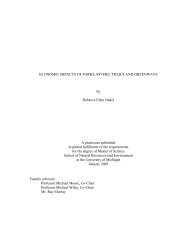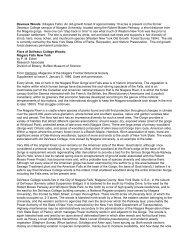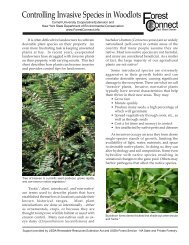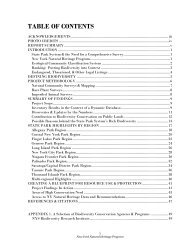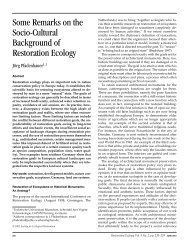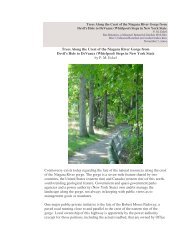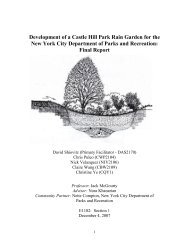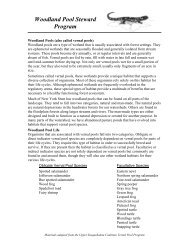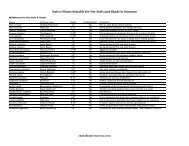Twenty years on: The state of contemporary ecotourism research
Twenty years on: The state of contemporary ecotourism research
Twenty years on: The state of contemporary ecotourism research
- No tags were found...
Create successful ePaper yourself
Turn your PDF publications into a flip-book with our unique Google optimized e-Paper software.
ARTICLE IN PRESSD.B. Weaver, L.J. Lawt<strong>on</strong> / Tourism Management 28 (2007) 1168–1179 1179Southgate, C. (2006). Ecotourism in Kenya: <strong>The</strong> vulnerabilities <strong>of</strong>communities. Journal <strong>of</strong> Ecotourism, 5, 80–96.Stein, T., Clark, J., & Rickards, J. (2003). Assessing nature’s role in<strong>ecotourism</strong> development in Florida: Perspectives <strong>of</strong> tourism pr<strong>of</strong>essi<strong>on</strong>alsand government decisi<strong>on</strong>-makers. Journal <strong>of</strong> Ecotourism, 2,155–172.Stewart, E., Kirby, V., & Steel, G. (2006). Percepti<strong>on</strong>s <strong>of</strong> Antarctictourism: A questi<strong>on</strong> <strong>of</strong> tolerance. Landscape Research, 31, 193–214.St<strong>on</strong>e, M., & Wall, G. (2005). Ecotourism and community development:<strong>The</strong> case <strong>of</strong> Jianfengling Nati<strong>on</strong>al Forest Park, Hainan, China. ChinaTourism Research, 1, 78–100.St<strong>on</strong>ehouse, B. (2001). Polar envir<strong>on</strong>ments (Arctic and Antarctic). In D.Weaver (Ed.), Encyclopedia <strong>of</strong> <strong>ecotourism</strong> (pp. 219–234). Wallingford,UK: CAB Internati<strong>on</strong>al.Svor<strong>on</strong>ou, E., & Holden, A. (2005). Ecotourism as a tool for naturec<strong>on</strong>servati<strong>on</strong>: <strong>The</strong> role <strong>of</strong> WWF Greece in the Dadia-Lefkimi-SoufliForest Reserve in Greece. Journal <strong>of</strong> Sustainable Tourism, 13, 456–467.Swain, M., & Swain, M. (2004). An ec<strong>of</strong>eminist approach to <strong>ecotourism</strong>development. Tourism Recreati<strong>on</strong> Research, 29, 1–6.Tao, C., Eagles, P., & Smith, S. (2004). Pr<strong>of</strong>iling Taiwanese ecotouristsusing a self-definiti<strong>on</strong> approach. Journal <strong>of</strong> Sustainable Tourism, 12,149–168.Tisdell, C., & Wils<strong>on</strong>, C. (2005). Perceived impacts <strong>of</strong> <strong>ecotourism</strong> <strong>on</strong>envir<strong>on</strong>mental learning and c<strong>on</strong>servati<strong>on</strong>: Turtle watching as a casestudy. Envir<strong>on</strong>ment, Development and Sustainability, 7, 291–302.Twidale, C., & Bourne, J. (2003). Commentary: Practices, problems andprinciples for <strong>ecotourism</strong>—A case study. Tourism Geographies, 5,482–492.Vincent, V., & Thomps<strong>on</strong>, W. (2002). Assessing community support andsustainability for <strong>ecotourism</strong> development. Journal <strong>of</strong> Travel Research,41, 153–160.Wearing, S. (1995). Pr<strong>of</strong>essi<strong>on</strong>alisati<strong>on</strong> and accreditati<strong>on</strong> <strong>of</strong> <strong>ecotourism</strong>.World Leisure & Recreati<strong>on</strong>, 37, 31–36.Wearing, S., & Neil, J. (1999). Ecotourism: Impacts, potentials andpossibilities. Oxford: Butterworth-Heinemann.Weaver, D. (Ed.). (2001a). <strong>The</strong> encyclopedia <strong>of</strong> <strong>ecotourism</strong>. Wallingford,UK: CABI.Weaver, D. (2001b). Ecotourism as mass tourism: C<strong>on</strong>tradicti<strong>on</strong> orreality? Cornell Hotel and Restaurant Administrati<strong>on</strong> Quarterly, 42,104–112.Weaver, D. (2002). Asian <strong>ecotourism</strong>: Patterns and themes. TourismGeographies, 4, 153–172.Weaver, D. (2005a). Comprehensive and minimalist dimensi<strong>on</strong>s <strong>of</strong><strong>ecotourism</strong>. Annals <strong>of</strong> Tourism Research, 32, 439–455.Weaver, D. (2005b). Mass and urban <strong>ecotourism</strong>: New manifestati<strong>on</strong>s <strong>of</strong>an old c<strong>on</strong>cept. Tourism Recreati<strong>on</strong> Research, 30, 19–26.Weaver, D. (in press). Ecotourism (2nd Ed.). Brisbane, Australia: Wiley.Weaver, D., & Lawt<strong>on</strong>, L. (2002). Overnight ecotourist marketsegmentati<strong>on</strong> in the Gold Coast hinterland <strong>of</strong> Australia. Journal <strong>of</strong>Travel Research, 40, 270–280.Weiler, B., & Ham, S. (2001). Tour guides and interpretati<strong>on</strong> in<strong>ecotourism</strong>. In D. Weaver (Ed.), Encyclopedia <strong>of</strong> <strong>ecotourism</strong>(pp. 549–563). Wallingford, UK: CAB Internati<strong>on</strong>al.Weiler, B., & Richins, H. (1995). Extreme, extravagant and elite: A pr<strong>of</strong>ile<strong>of</strong> ecotourists <strong>on</strong> Earthwatch expediti<strong>on</strong>s. Tourism Recreati<strong>on</strong> Research,20, 29–36.Wight, P. (1993). Ecotourism: Ethics or eco-sell? Journal <strong>of</strong> TravelResearch, 31, 3–9.Wight, P. (1995). Sustainable <strong>ecotourism</strong>: Balancing ec<strong>on</strong>omic, envir<strong>on</strong>mentaland social goals within an ethical framework. TourismRecreati<strong>on</strong> Research, 20(1), 5–13.Wight, P. (1996). North American ecotourists: Market pr<strong>of</strong>ile and tripcharacteristics. Journal <strong>of</strong> Travel Research, 34, 2–10.Wight, P. (2001). Ecotourists: Not a homogeneous market segment. In D.Weaver (Ed.), Encyclopedia <strong>of</strong> <strong>ecotourism</strong> (pp. 37–62). Wallingford,UK: CAB Internati<strong>on</strong>al.Wunder, S. (2000). Ecotourism and ec<strong>on</strong>omic incentives—An empiricalapproach. Ecological Ec<strong>on</strong>omics, 32, 465–479.Yaman, A., & Mohd, A. (2004). Community-based <strong>ecotourism</strong>: A newpropositi<strong>on</strong> for sustainable development and envir<strong>on</strong>mental c<strong>on</strong>servati<strong>on</strong>in Malaysia. Journal <strong>of</strong> Applied Science, 4, 583–589.Yu, D., Hendricks<strong>on</strong>, T., & Castillo, A. (1997). Ecotourism andc<strong>on</strong>servati<strong>on</strong> in Amaz<strong>on</strong>ian Peru: Short-term and l<strong>on</strong>g-term challenges.Envir<strong>on</strong>mental C<strong>on</strong>servati<strong>on</strong>, 24, 130–138.Zeppel, H. (2006). Indigenous <strong>ecotourism</strong>: Sustainable development andManagement. Wallingford, UK: CABI.Zografos, C., & Kenrick, J. (2005). Negotiating ‘indigenousness’ through<strong>ecotourism</strong> in the Amaz<strong>on</strong>ian Ecuador. Tourism, 53, 205–215.Zografos, C., & Oglethorpe, D. (2004). Multi-criteria analysis in<strong>ecotourism</strong>: Using goal programming to explore sustainable soluti<strong>on</strong>s.Current Issues in Tourism, 7, 20–43.Zwirn, M., Pinsky, M., & Rahr, G. (2005). Angling <strong>ecotourism</strong>: Issues,guidelines and experience from Kamchatka. Journal <strong>of</strong> Ecotourism, 4,16–31.




